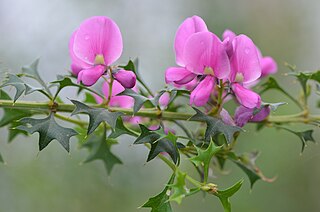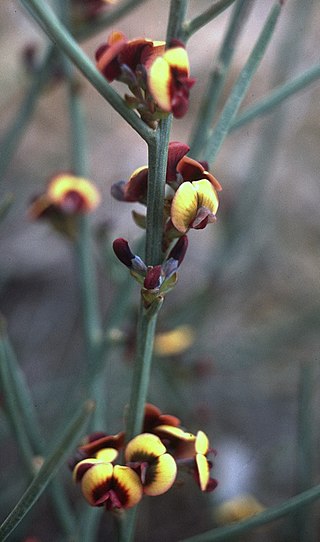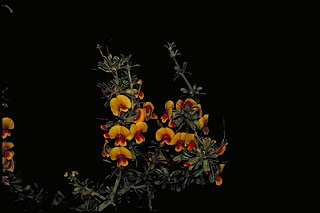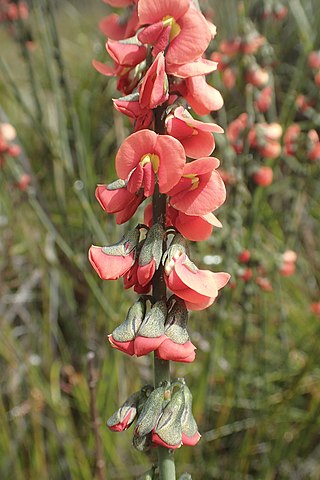Persoonia manotricha is a species of flowering plant in the family Proteaceae and is endemic to Western Australia. It is an erect shrub with hairy young branchlets, more or less cylindrical leaves and greenish yellow flowers in groups of up two to eight on a rachis 2–15 mm (0.079–0.591 in) long. It is similar to P. bowgada and P. hexagona but has longer pedicels than P. bowgada and differently grooved leaves from P. hexagona.

Mirbelia dilatata, commonly known as holly-leaved mirbelia, is a species of flowering plant in the family Fabaceae and is endemic to the south-west of Western Australia. It is an erect, bushy, shrub with prickly leaves and pink, purple or violet flowers.
Gompholobium karijini is a species of flowering plant in the family Fabaceae and is endemic to the north-west of Western Australia. It is an erect, openly-branched shrub with pinnate leaves with five to ten pairs of leaflets, and racemes of yellow to orange and creamy-yellow, pea-like flowers.
Gompholobium oreophilum is a species of flowering plant in the family Fabaceae and is endemic to the north-west of Western Australia. It is an erect shrub with pinnate leaves with elliptic leaflets, and racemes of yellow to orange and creamy-yellow, pea-like flowers.

Daviesia debilior is a species of flowering plant in the family Fabaceae and is endemic to the south-west of Western Australia. It is a shrub with low-lying stems and many erect branchlets, scattered linear to scale-like phyllodes, and yellow, purplish, orange-pink and dark purplish flowers.
Daviesia eremaea is a species of flowering plant in the family Fabaceae and is endemic to central Australia. It is an erect, glabrous, multi-stemmed shrub with needle-like, more or less sharply-pointed phyllodes, and yellow and red flowers.

Daviesia euphorbioides, commonly known as Wongan cactus, is a species of flowering plant in the family Fabaceae and is endemic to a restricted area in the south-west of Western Australia. It is an open, erect to sprawling, cactus-like shrub with thick, fleshy branchlets and phyllodes reduced to scattered, sharply-pointed spines, and bright yellow, reddish-brown and maroon flowers.

Daviesia localis is a species of flowering plant in the family Fabaceae and is endemic to a restricted area of the south-west of Western Australia. It is an erect, spreading shrub with spine-tipped branchlets, scattered, spreading, curved, needle-shaped, sharply-pointed phyllodes and orange-yellow and red flowers with a v-shaped central mark.
Daviesia pectinata, commonly known as thorny bitter-pea, is a species of flowering plant in the family Fabaceae and is endemic to south-eastern continental Australia. It is a dense, rigid shrub with erect, flattened branchlets, crowded, flattened, triangular phyllodes, and yellow to orange and reddish flowers.

Daviesia pedunculata is a species of flowering plant in the family Fabaceae and is endemic to south-western Western Australia. It is a spreading or sprawling to erect shrub with erect, egg-shaped to elliptic phyllodes, and yellow and maroon flowers.
Daviesia podophylla, commonly known as buggery bush, is a species of flowering plant in the family Fabaceae and is endemic to the south-west of Western Australia. It is an openly-branched, glabrous, glaucous shrub with many often sharply-pointed branchlets, triangular phyllodes with a sharp point on the end, and orange-yellow, dark red and black flowers.

Daviesia quadrilatera, commonly known as buggery bush, is a species of flowering plant in the family Fabaceae and is endemic to the south-west of Western Australia. It is a robust, erect, glabrous shrub with angular branchlets, vertically flattened, sharply-pointed quadrilateral or triangular phyllodes with a sharp point on the end, and yellow to orange and red flowers.
Sphaerolobium benetectum is a species of flowering plant in the family Fabaceae and is endemic to the south-west of Western Australia. It is tuft-forming sub-shrub with erect stems, linear to lance-shaped leaves, and yellow-orange and pink to red flowers.
Mirbelia corallina is a species of flowering plant in the family Fabaceae and is endemic to the far west of Western Australia. It is a slender, sprawling sub-shrub with a few narrowly elliptic to narrowly egg-shaped leaves and pink and yellow flowers arranged in racemes near the ends of the branchlets.
Mirbelia ferricola is a species of flowering plant in the family Fabaceae and is endemic to inland parts of the south-west of Western Australia. It is an erect shrub with leaves reduced to small scales, and red and yellow flowers arranged in racemes at the ends of the branches.

Mirbelia granitica is a species of flowering plant in the family Fabaceae and is endemic to inland areas of Western Australia. It is an erect or spreading shrub with spiny branches, scattered linear to narrowly egg-shaped leaves and yellow and red flowers.
Sphaerolobium pubescens is a species of flowering plant in the family Fabaceae and is endemic to the south of Western Australia. It is a small shrub or subshrub with slender stems, tapering linear leaves and dense racemes of yellow flowers.

Sphaerolobium rostratum is a species of flowering plant in the family Fabaceae and is endemic to the south of Western Australia. It is an erect to sprawling shrub or subshrub with slender stems, tapering linear leaves and loose racemes of pink and cream-coloured flowers.

Mirbelia ramulosa is a species of flowering plant in the family Fabaceae and is endemic to the south-west of Western Australia. It is an erect, much-branched, spiny, leafless shrub with yellow and red, purple or brown flowers.
Mirbelia stipitata is a species of flowering plant in the family Fabaceae and is endemic to inland areas of Western Australia. It is a spiny, more or less leafless shrub with yellow and red flowers.








